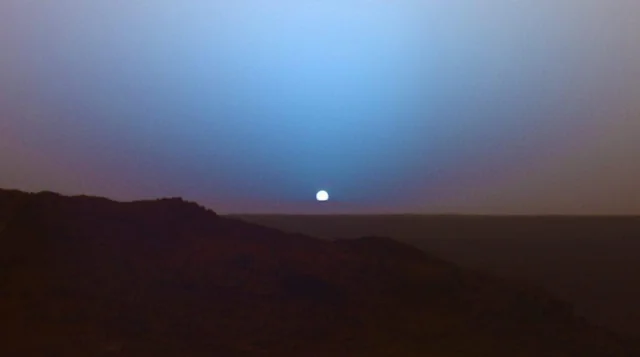When we look at Earth and Mars, it feels like they had to pick a primary color scheme and stick with it. Earth is the quintessential pale blue dot, in opposition to Mars’s moniker as the Red Planet. But the scheme is turned on its head when we talk about sunsets. Our vivid scarlet sunsets are pitted against the pale sapphire sunsets of Mars.
The different palette is actually based on the same scientific principles. The sunsets on Mars are blue in a similar way to how our sky is blue and our sunsets are red. It’s all down to the scattering of sunlight on the molecules that make up our atmosphere.
While appearing white, sunlight comprises many different wavelengths – which we recognize as different colors – and molecules and dust particles interact only with certain wavelengths. By scattering specific portions of the light spectrum, these particles produce the color we see.

Now, Mars’s atmosphere is very different from Earth’s own, both in composition and in density. Mars’s atmosphere is very tenuous. Its pressure is equivalent to about 1 percent of Earth’s. To experience such low pressure on Earth, you’d need to be at over 30 kilometers (18 miles) of altitude. It also lacks nitrogen and oxygen.
Mars’s atmosphere is made of carbon dioxide and has a lot of dust. This fine dust tends to scatter red light so that the sky appears reddish, which lets the blue light through. On Earth, it is the other way around. Blue light bounces off air molecules giving our sky its characteristic hue, and at sunset and dawn, those longer wavelengths are predominant.
When the Sun appears low on the horizon, light has a longer distance to travel within the atmosphere, so it scatters more. What is left is the color that we see. On Earth, we have a wider palette of reds, which is actually amplified by ash from volcanoes and dust from fires. On Mars, we get a cool blue hue.
Perseverance, Curiosity, Spirit, Opportunity, InSight and even the Zhurong rover have witnessed the extraordinary blue sunset. And it is a good thing, given that Mars and Earth are some of the few places where we can see atmospheric color changes at dusk and dawn. Many other terrestrial bodies in the Solar System either lack an atmosphere thick enough to produce an effect, or have one with clouds so thick that you won’t get to see anything.
Consider Venus, where the pressure, temperature, and acid clouds would have killed you long before sunset. Titan might be an exception, but the sunset might end up being in infrared, or only an occasional occurrence when the clouds part at the right time.
So, if we like a good sunset we have two places from which to choose for a guaranteed spectacle. We just need to decide if we like more a blue-to-red setup or a red-to-blue one.




